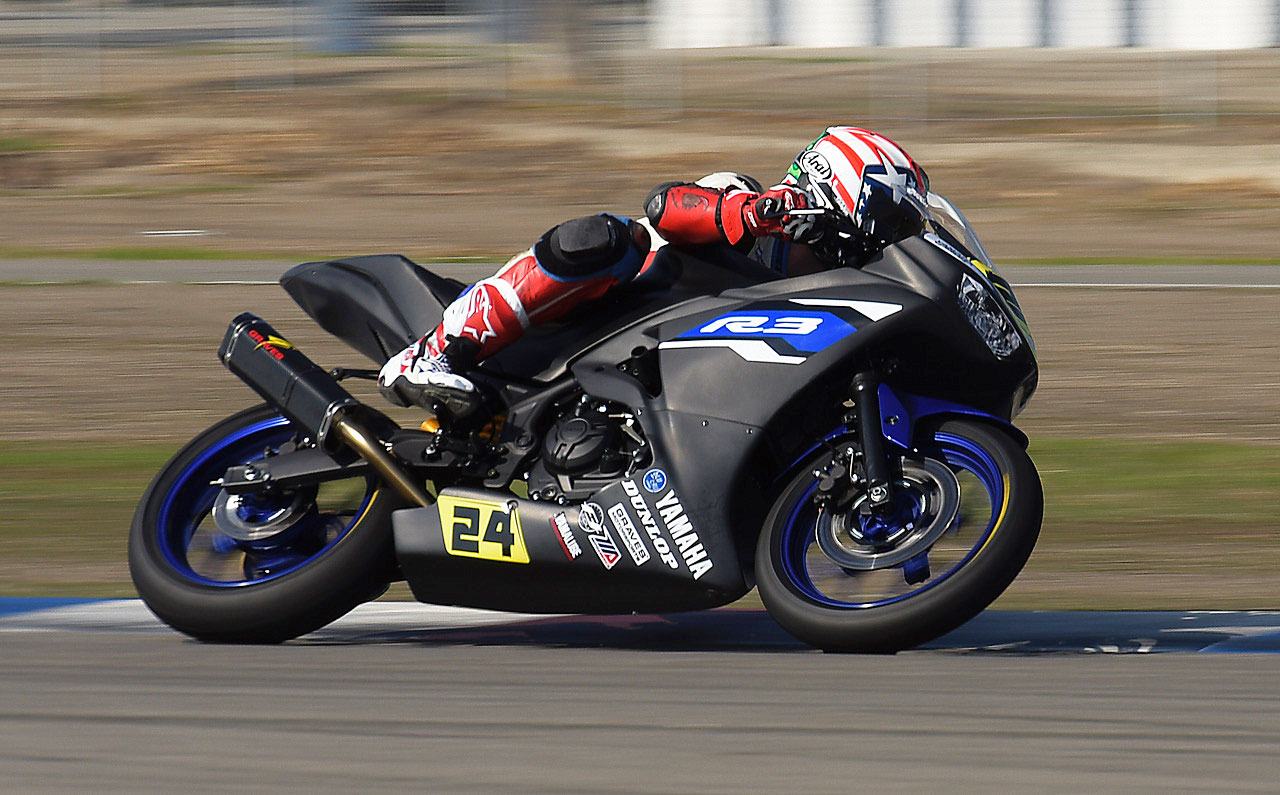American Motorcyclist April 2018
Racing To The Starting Grid
MotoAmerica’s Multi-Manufacturer Junior Cup To Groom Talent
► AMA members get exclusive access to American Motorcyclist every month! Join The AMA Today!

MotoAmerica’s previous spec-based KTM RC390 Cup (shown here) has been replaced by the new Liqui Moly Junior Cup.
By Michael Marino
For the 2018 season, MotoAmerica, the home of the AMA Superbike Championship, is changing its smallest-displacement class to grow opportunities for America’s up-and-coming road racing talent. The Liqui Moly Junior Cup replaces the previous spec-based KTM RC390 Cup.
The Liqui Moly Junior Cup provides an arena for multiple brands to demonstrate the performance and durability of their small-displacement sportbike models.
During the 2018 season, fans and teams will see whether the changes improve brand diversity in MotoAmerica’s feeder class, drive opportunities for sponsorship and manufacturer support, develop the sport’s future stars, and impact the cost of getting started in professional road racing.
Climbing The Ladder
For many racing fans, AMA Superbike is often thought of in terms of its glitz, glamour and sophistication. Images of computer programmers plugging laptops into exotic, race-prepped sportbikes and team members enjoying fine dining inside manufacturers’ hospitality tents might come to mind.
Those images hold true for the top tier of teams competing in MotoAmerica, but for most of the paddock the reality is hard work, sweat and sacrifice.
In this down-to-earth setting, we will find the next Nicky Hayden or Ben Spies at the dawn of their road racing careers. After all, no one is born into a factory ride.
In the few years prior to MotoAmerica acquiring the rights to promote the AMA Superbike Championship, America’s professional road racing series, even the feeder classes were barely reachable for many of America’s future racing stars.
Middleweight, 600cc sportbikes made up the smallest displacement class. Young racers had to compete on expensive, powerful sportbikes in the same classes as far more experienced competitors. While there was talk of creating a small-displacement, entry-level class, those discussions never came to fruition.

A Graves-prepped Yamaha R3s. Photo by Graves / Yamaha
The KTM RC390 Cup
In 2015, when MotoAmerica came on the scene and the AMA resumed sanctioning responsibilities for the series, the two entities created the KTM RC390 Cup to foster and develop new talent.
During the past three seasons, the class has helped dozens of talented young road racers showcase and develop their talent on small-displacement motorcycles.
The RC Cup pitted pro road racers against each other on identical, race-prepped 373cc, single-cylinder KTM RC390s, allowing young racers to develop their talents with lower operating costs and reduced chances of a major injury.
The class rulebook required factory-prepared and sealed engines. It also restricted what teams could modify on the bike’s chassis or suspension. The result was a class that was financially accessible for many families, as well as a level playing field.
The RC Cup often produced the best on-track battles of all the classes.
“For the initial three seasons of MotoAmerica, the KTM Cup provided the entry level to the series,” said MotoAmerica partner Chuck Aksland. “It provided great competition, and we have seen some great talent come up through the class.”
Why Change?
More Manufacturers
For the Liqui Moly Junior Cup, motorcycles from four different manufacturers have been homologated to compete in the class.
- Honda CBR500R
- Kawasaki Ninja 300
- Kawasaki Ninja 400
- KTM RC390
- KTM RC390 R
- Yamaha YZF-R3
There are reasons to change something that was apparently working so well.
Any spec-based class is tethered to one manufacturer’s showroom. As sales of middleweight sportbikes have tumbled, small-displacement motorcycles have become more important to all brands.
To enhance MotoAmerica as a development and marketing platform for all new sportbikes, it had to adapt.
American road racing also has been aligning with international norms for the sport. Several classes now conform to international production-based motorcycle road racing.
With the advent of the Superbike World Championship’s Supersport 300 class in 2017, MotoAmerica had good reason to develop a more open 300 class of its own.
“After watching [the Supersport 300 class] and seeing the popularity of the class, we decided to follow in the direction of this category and replicate the class here in MotoAmerica for 2018,” Aksland said.
The change also is part of a broader plan to reorganize MotoAmerica competition classes for 2018, according to AMA Director of Road Racing Relations Bill Cumbow.
“The creation of the Junior Cup was part of MotoAmerica’s broader class structure for the 2018 season,” Cumbow said. “MotoAmerica realizes the potential of this class and wants to elevate it to the level of Supersport and Superbike.”
Cumbow adds that the Liqui Moly Junior Cup signifies the evolution and expansion of the junior class’ role in the series. It will groom future national and international American road racing champions, while better serving the product development and marketing needs of motorcycle manufacturers.
What is Changing?
The biggest and most obvious change to MotoAmerica’s junior class is its conversion from a single-manufacturer class to a multiple-manufacturer class.
Motorcycles from four different manufacturers have been homologated to compete in the class.
They are:
- Honda CBR500R
- Kawasaki Ninja 300
- Kawasaki Ninja 400
- KTM RC390
- KTM RC390 R
- Yamaha YZF-R3
Weight limits and rev limits have been specified for each homologated model to maintain performance parity. Those specifications are open to change throughout the 2018 season.
Additionally, the new rules allow teams to make more modifications to their bikes. Junior Cup teams have a small amount of latitude in modifying their bike’s engine, transmission and frame.
For example, teams are now free to adjust cam timing, and swap clutches and sub-frames with aftermarket parts.
Teams will also be free to use aftermarket brake pads, brake rotors, brake lines, exhaust systems and engine oil. The number of tires allowed per round will increase from four to six.
The new rules also give teams much wider latitude on suspension tuning.
Teams are free to use front fork internals and rear shocks from an approved list. The forks and shocks are price-capped, and suspension manufacturers must make their approved units available to all Junior Cup teams. Teams must use only tuning parts from the suspension manufacturer.
All Junior Cup competitors are still using Dunlop tires. Expensive technologies such as data logging and telemetry are banned in the class. Teams are still required to use many original equipment parts, including wheels, frames, fuel tanks and swingarms.
Uncertainty And Opportunity
Without the new Junior Cup having turned a wheel on track yet, it is too early to say what effect the new rules may have.
Regarding cost, MotoAmerica and the AMA have mandated cost caps on expensive components and limited modifications.
“If anything, [the changes] should reduce the cost of participation by allowing more manufacturer options,” Aksland said. “In addition, the competing factories have posted some really good contingency benefits, so overall it looks to be a real win-win for everyone.”
Also, any time a series or competition class moves away from a tightly-crafted spec rulebook, it creates opportunities for stronger machine performance that better funded teams can exploit. It’s possible that the more open class structure could unbalance the competitive landscape.
Despite these uncertainties, the new structure creates opportunities for additional investment and more comprehensive support programs from motorcycle manufacturers.
Despite no longer being the class’ sole marque, KTM has renewed its commitment to MotoAmerica’s smallest displacement class.

Graves/Yamaha YZF-R3 Support Program riders Chase Lyons, Jackson Blackmon, Hunter Dunham, Joseph Blasius, Toby Khamsouk, Gage Rees, Cory Ventura, Dylan Deutschlander, and Tyler Wissel pose with Yamaha Factory Racing Ambassador Josh Hayes during the program’s orientation camp at Buttonwillow Raceway Park. Photo by Graves / Yamaha
“KTM wanted to go forward with the RC Cup,” said Chris Fillmore, KTM brand ambassador and former factory Superbike racer. “We considered it the best, low-cost way to do a feeder series. KTM is a ‘ready to race’ company, and we are ready to fully support KTM riders in the Junior Cup going forward.”
Fillmore said he will attend most of the Junior Cup races and continue to serve as a coach and mentor to KTM riders, much like he did during MotoAmerica’s RC390 Cup years.
Additionally, KTM North America will make its former factory Superbike crew chief Uli Toporsch available to Junior Cup competitors riding KTMs. Toporsch will be on hand to provide teams with technical advice.
Another manufacturer stepping up to support the new Junior Cup is Yamaha.
The Monster Energy Graves Yamaha Superbike team that has won seven of the last eight Superbike titles has created the Graves/Yamaha YZF-R3 Support Program.
The program will allow customer Junior Cup teams to purchase Graves-prepped Yamaha R3s, and will include season-long technical support from the Graves organization.
Graves/Yamaha held a two-day orientation session in early February, where 9 Junior Cup racers were introduced to their Graves-prepared Yamaha R3s. The riders also were able to take their machines out on Buttonwillow Raceway Park’s road course.
Like the KTM program, the Graves Yamaha program is making a rider coach available to its riders. Four-time Superbike champion Josh Hayes will serve as the Yamaha Factory Racing Ambassador for the program. Hayes will be on hand to provide coaching and mentorship to Graves/Yamaha YZF-R3 Support Program riders throughout the Junior Cup season.
The opening of the class to additional aftermarket parts also creates additional sponsorship opportunities for Junior Cup teams. Under the RC Cup, many parts were restricted to homologated parts produced or provided by KTM. By opening up clutches, brake parts, and suspension to major aftermarket brands, Junior Cup teams may be able to seek additional financial support, obtain more discounted or free parts or qualify for additional contingency funding.
Moving Forward
What is clear with the new Junior Cup is that series organizers recognize the importance of rider development.
MotoAmerica has demonstrated from its launch that it understands the need to identify, train and support America’s up-and-coming road racing talent, and the AMA has supported those efforts.
The new class’ more open structure will allow for additional financial and technical support to find its way to the families of young road racers, and, potentially, continue to lower the families’ financial burden of pursuing a career in professional road racing.
As of March 1, bikes from Yamaha, KTM and Kawasaki were slated for the Junior Cup grid when MotoAmerica begins the 2018 season April 13-15 at Road Atlanta.

